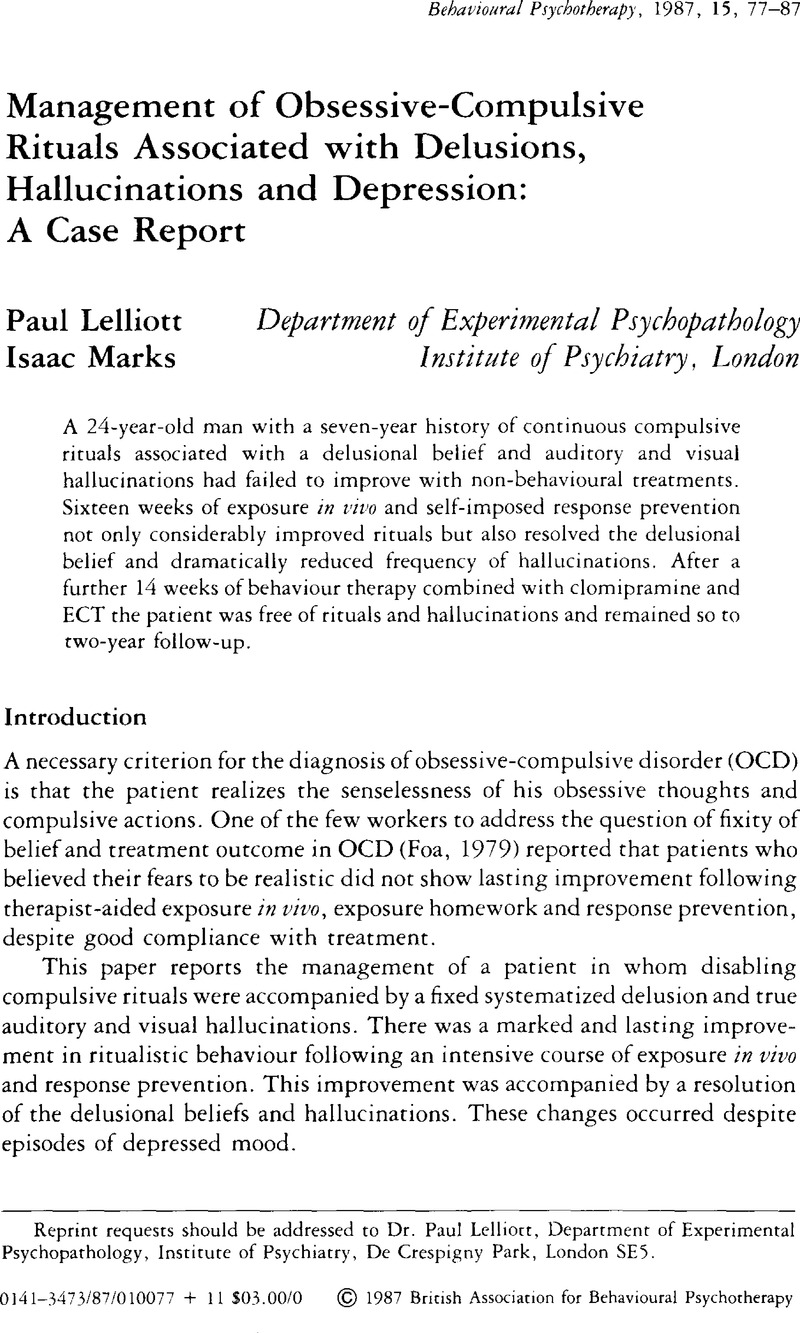Crossref Citations
This article has been cited by the following publications. This list is generated based on data provided by Crossref.
Marks, Isaac
1988.
[No Title].
British Journal of Psychiatry,
Vol. 153,
Issue. 4,
p.
568.
Lelliott, P. T.
Noshirvani, H. F.
Başoǧlu, M.
Marks, I. M.
and
Monteiro, W. O.
1988.
Obsessive-compulsive beliefs and treatment outcome.
Psychological Medicine,
Vol. 18,
Issue. 3,
p.
697.
Marks, Isaac
and
Mishan, Joseph
1988.
Dysmorphophobic Avoidance with Disturbed Bodily Perception.
British Journal of Psychiatry,
Vol. 152,
Issue. 5,
p.
674.
Başoğlu, Metin
Lax, Teresa
Kasvikis, Yiannis
and
Marks, Isaac M.
1988.
Predictors of improvement in obsessive-compulsive disorder.
Journal of Anxiety Disorders,
Vol. 2,
Issue. 4,
p.
299.
Megens, Jozef
and
Vandereycken, Walter
1989.
Hospitalization of obsessive-compulsive patients: The “forgotten” factor in the behavior therapy literature.
Comprehensive Psychiatry,
Vol. 30,
Issue. 2,
p.
161.
Cottraux, Jean
1989.
Behavioural Psychotherapy for Obsessive-Compulsive Disorder.
International Review of Psychiatry,
Vol. 1,
Issue. 3,
p.
227.
Gurnani, Prem D.
and
Wang, Michael
1990.
Some reservations concerning the current cognitive emphasis in therapy.
Counselling Psychology Quarterly,
Vol. 3,
Issue. 1,
p.
21.
Gomez-Perez, JC
Marks, IM
and
Gutierrez-Fisac, JL
1994.
Dysmorphophohia: clinical features and outcome with behavior therapy.
European Psychiatry,
Vol. 9,
Issue. 5,
p.
229.
Kozak, Michael J.
and
Foa, Edna B.
1994.
Obsessions, overvalued ideas, and delusions in obsessive-compulsive disorder.
Behaviour Research and Therapy,
Vol. 32,
Issue. 3,
p.
343.
Ito, Ligia M.
de Araujo, Luiz A.
Hemsley, Dave R.
and
Marks, Isaac M.
1995.
Beliefs and resistance in obsessive-complulsive disorder: Observations from a controlled study.
Journal of Anxiety Disorders,
Vol. 9,
Issue. 4,
p.
269.
Eisen, Jane L.
Phillips, Katharine A.
Baer, Lee
Beer, Douglas A.
Atala, Katherine D.
and
Rasmussen, Steven A.
1998.
The Brown Assessment of Beliefs Scale: Reliability and Validity.
American Journal of Psychiatry,
Vol. 155,
Issue. 1,
p.
102.
Marks, Isaac
1999.
Commentary.
Advances in Psychiatric Treatment,
Vol. 5,
Issue. 3,
p.
178.
Neziroglu, Fugen
McKay, Dean
Yaryura-Tobias, Jose A
Stevens, Kevin P
and
Todaro, John
1999.
The overvalued ideas scale: development, reliability and validity in obsessive–compulsive disorder1A preliminary report of this study was presented at the 66th meeting of the Eastern Psychological Association, Boston, MA and the meeting of the World Congress for Behavioral and Cognitive Therapies, Copenhagen, Denmark. Dean McKay is now at Fordham University, Department of Psychology, Bronx, NY. John Todaro is now at University of Florida, Department of Psychology, Gainesville, FL.1.
Behaviour Research and Therapy,
Vol. 37,
Issue. 9,
p.
881.
O'Dwyer, Anne-Marie
and
Marks, Isaac
2000.
Obsessive-compulsive disorder and delusions revisited.
British Journal of Psychiatry,
Vol. 176,
Issue. 3,
p.
281.
Bermanzohn, Paul C
2000.
The Potential Role of Associated Psychiatric Syndromes in Subtyping Schizophrenia.
Psychiatric Annals,
Vol. 30,
Issue. 10,
p.
659.
Bermanzohn, Paul C.
Porto, Linda
Siris, Samuel G.
Stronger, Roz
Hwang, Michael Y.
and
Pollack, Simcha
2001.
Schizophrenia and Comorbid Conditions: Diagnosis and Treatment.
p.
1.
Tolin, David F
Abramowitz, Jonathan S
Kozak, Michael J
and
Foa, Edna B
2001.
Fixity of belief, perceptual aberration, and magical ideation in obsessive–compulsive disorder.
Journal of Anxiety Disorders,
Vol. 15,
Issue. 6,
p.
501.
Phillips, Katharine A
2002.
The obsessive-compulsive spectrums.
Psychiatric Clinics of North America,
Vol. 25,
Issue. 4,
p.
791.
Eisen, Jane L
Phillips, Katharine A
Coles, Meredith E
and
Rasmussen, Steven A
2004.
Insight in obsessive compulsive disorder and body dysmorphic disorder.
Comprehensive Psychiatry,
Vol. 45,
Issue. 1,
p.
10.
Phillips, Katharine A.
2004.
Psychosis in body dysmorphic disorder.
Journal of Psychiatric Research,
Vol. 38,
Issue. 1,
p.
63.




Comments
No Comments have been published for this article.